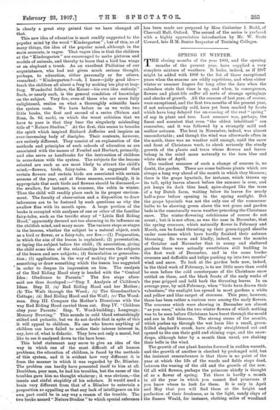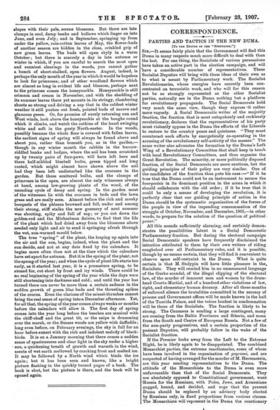SPRING IN WINTER.
THE closing months of the year 1906, and the opening months of the present year, have supplied a very complete mixture of weathers. It looks, indeed, as if 1907 might be added with 1906 to the list of those exceptional years when the seasons are oddly capricious, and when either winter or summer lingers for long after the date when the calendars state that time is up, and when, in consequence, flowers and plant-life suffer all sorts of strange springiugs and checks of growth. All the seasons of last year, of course, were exceptional, and the first two months of the present year, if not extraordinarily cold, have yet been marked by frosts which have long delayed the on-coming of the real " spring" of sap in plant and tree. Last summer was, perhaps, the finest and sunniest that even "the oldest inhabitant" can remember, and it was followed by a strangely, mild and mellow autumn. The heat in November, indeed, was almost uncomfortable ; and though the wind was afterwards often in the north, there was no weather cold enough, until the snow and frost of Christmas week, to check seriously the steady growth of the plants and trees whose flowers and leaves belong in the mind more naturally to the torn blue and white skies of April.
The readiest measure of such a change of seasons is, no doubt, the garden. There are some bulbous plants which, are always a long way ahead of the month in which they blossom ; there is the grape hyacinth, for instance, which throws up its tall, spiky leaves almost before the summer is over, and yet keeps its dark bine head, spire-shaped like the trees of a toy Dutch farm, waiting below its leaves for nearly half-a-year before opening in the spring sunlight. But the grape hyacinth was not the only one of the commoner bulbs to be showing green above the wet grass and garden beds in the unnaturally warm weather preceding the Christmas snow. The winter-flowering colchicums of course do not count ; but it is not often, as was the case in December, that the spring crocuses, which naturally flower in February and March, can be found thrusting up their green-tipped sheaths under rose-trees which have hardly finished their autumn blooming. So warm and kindly, indeed, were the months of October and November that in sunny and sheltered gardens there were actually sweetbriers still budding in the first week of December, and in the earns border crocuses and daffodils and tulips pushing up into two months' wind and snow. To look at the garden beds now, indeed, in the third week of February, is to see little more than could be seen before the cold counterpane of the Christmas snow settled on them, and the black frosts of the early weeks of the year gripped and held back the thrusting leaves. In an average year, by mid-February, when "birds have drawn their valentines," the sunlight has spread in most gardens a white and yellow and lilac carpet of crocuses. This year, however, there has been rather a curious race among the early flowers. The crocuses which were showing in December are almost "as you were," while the two winter flowers of which nothing was to be seen before Christmas have burst through the mould and are in full blossom. The strong stems of the aconite, which pushes up through the wet loam like a small, green- frilled shepherd's crook, have already straightened out and opened to the sun their gold and shining cups, and the snow- drops, although later by a month than usual, are shaking their bells in the wind.
The growth of one plant hurries forward in sudden warmth, and the growth of another is checked by prolonged cold, but the insistent remembrance is that there is no point of the year at which the life of the woods and fields stops dead, between the waning of the old and the growth of the new. Of all wild flowers, perhaps the primrose chiefly is thought of as a flower of spring. Yet there is hardly a month in all the year in which you cannot find primroses if
you know where to look for them. It is only in April and May that you will find them at the height and perfection of their freshness, as in the light, sandy clays of the Sussex Weald, for instance, clothing miles of woodland slopes with their pale, serene blossoms. But there are late clumps in cool, damp banks and hollows which linger on into June, and even July; and in September, springing up from under the yellow, rain-rotten leaves of May, the flower-buds of another season are hidden in the close, crinkled grip of new green leaves. The buds will open shyly in a warm October ; but there is scarcely a day in late autumn or winter in which, if you are careful to search the most open and sunniest clearings in the woods, you cannot gather a bunch of short-stalked, open flowers. August, indeed, is perhaps the only month of the year in which it would be hopeless to look for primroses; and of other woodland flowers which are almost as long in evident life and blossom, perhaps next to the primrose comes the honeysuckle. Honeysuckle is still crimson and cream in November, and with the shedding of its summer leaves there yet mounts in its stringy, clambering shoots so strong and driving a sap that in the coldest winter weather it still pushes out fresh, pointed buds of mauve and glaucous green. Or, for promise of surely returning sun and West winds, look above the honeysuckle at the boughs round which it climbs, and watch the catkins of the hazel swinging white and soft in the gusty North-easter. In the woods, possibly because the whole floor is covered with fallen leaves, the earliest signs of spring will always be found above and about you, rather than beneath you, as in the gaklen,— though in any winter month the rabbits in the burrow. riddled banks and hedges, where the soil has been scratched up by twenty pairs of fore-paws, will have left here and there half-nibbled bluebell bulbs, green tipped and long rooted, which might almost have shown above the soil had they been left undisturbed like the crocuses in the garden. But those scattered bulbs, and the clumps of primroses in the open, are almost the only witnesses always at hand, among low-growing plants of the wood, of the unending cycle of decay and spring. In the garden most of the witnesses lie with the crocuses in beds and the lawn grass and are easily seen. Almost before the rich and musky bouquets of the phloxes browned and fell, ander and among their strong, stiff stalks the new greenery of next summer was shooting, spiky and full of sap ; or you cut down the golden-rod and the Michaelmas daisies, to find that the life of the plant which had dried away from the blossoms above needed only light and air to send it springing afresh through the wet, sun-warmed mould below.
The true " spring " of the plant, the leaping up again into the air and the sun, begins, indeed, when the plant and the sun decide, and not at any date fixed by the calendars. It begins more often than not at the time which the calendars have set apart for autumn. But it is the spring of the plant, not the spring of the year; and when the cycle of plant life starts too early, as it started last year, it is a premature spring, to be atoned for, cut short by frost and icy winds. There could be no real beginning of the spring of the year while the days were still shortening into darkness and cold ; and until the year has turned there can never be more than a certain sadness in the sudden growth of green lilac buds and the thrusting spikes of the crocus. Even the clarions of the missel-thrushes cannot bring the real sense of spring into a December afternoon. Yet, for all that, the spring of the year comes always weeks or months before the calendars will allow it. The first day of spring comes into the year long before the beeches are musical with the chill-chaff and the great tit, or the snipe is drumming over the marsh, or the Sussex woods are yellow with daffodils; long even before, on February evenings, the sky is full for an hour before sunset with the rich and indolent melody of black- birds. It is on a January Morning that there comes a sudden sense of spaciousness and clear light in the sky under a higher sun, a quickening breath of growth and warmth in the wind, scents of wet earth mellowed by cracking frost and melted ice. It may be followed by a North wind which binds the ice again; but it has been seen and known, like a bright picture flashing in the quickly turned pages of a book. The book is abut, but the picture is there, and the book will be opened again.











































 Previous page
Previous page